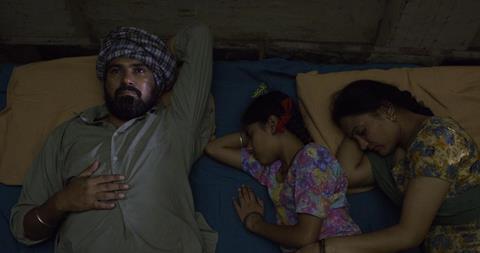Dir. Gurvinder Singh. India, France, 2015. 115 min.

More remarkable for its imaginative direction and colorful photography than for the political message it attempts to deliver, Gurvinder Singh’s second feature The Fourth Direction (Chauthi Koot) combines two unrelated stories in attempt to recreate the fear, suspicion and paranoia generated by the Punjab insurgency in the early 1980’s, which culminated in the assassination of Indira Gandhi.
While the plot’s moral code is fairly obvious, Singh’s directorial choices are often remarkably effective
Singh doesn’t try to explain the background to the confrontation between Punjabi militants and the Indian government, focusing on the climate they created rather than the events which took place. The Fourth Direction points out that the real victims of the conflict were not just the thousands who were shot on both sides, but the locals caught up in the fighting. Only wanting to be left alone, they were alternately terrorized by both the forces of law and order and the rebels fighting them. As such, Singh’s message is easily applied to present-day conflicts more familiar to contemporary audiences, from Boko Haram to Isis. This gives The Fourth Direction the potential to sit comfortably on Western arthouse screens - but not before something is done about its self-indulgent pace.
The film’s first episode shows two Hindus Jugal (Kamwaljeet Singh) and Raj (Harnet Aulakh), in a hurry to reach the Sikh holy city of Amritsar, who force their way on a freight train the army has ordered to travel empty and find themselves in the company of an irate guard and several more illegal passengers.
In a second, bridge episode which flashes back in time five months to June, 1984, Jugal and his wife and child are lost at night in the Punjabi countryside. They reach the house of a villager, Joginder (Suvinder Vikki), who offers his hospitality and then shows them the direction they have to take.
Then, in the film’s main section, Joginder and his family are visited at night by the village’s Sikh terrorist cell who first beat them up, and then insist they kill the family dog which is drawing the attention of the military with its incessant barking.
Next day, it’s the turn of the military to arrive. They turn the house upside down, suspecting guerilla fighters are hidden there. Both sides treat Joginder and his family with the same brutal authority awarded to people who carry guns. The finale takes the plot back into the train chugging on its way to Amritsar, with the guard asking his unwanted passengers to leave before anyone notices them.
While the plot’s moral code is fairly obvious, Singh’s directorial choices are often remarkably effective, whether in the camera angles, the long travelling shots, the nervous tension and insecurity transmitted in every glance and reflected in every silence and echoed in every sound. His actors’ faces are powerfully expressive, while the empty fields of the Punjab seem threatening despite their innocent aspect (a kind of nod to Hitchcock’s North by Northwest).
Unfortunately, the pace inflicted on the above – with prolonged sequences and themes repetitively overstated – risk alienating viewers to the point where 30 minutes less would be so much more.
Production companies: Film Café, Catherine Dussart Production
International Sales: Elle Driver (sales@elledriver.eu)
Producer: Kartikeya Singh
Screenplay: Guvinder Singh, Waryam Singh Sandu, Jasdeep Singh based on story by Sandhu
Cinematography: Satia Rai Nagpaul
Editing: Bhupesh Micky Sharma
Production design: Priyanka Grover, Navjit Kaur
Music: Marc Marder
Cast: Suvinder Vikky, Rajbir Kaur, Gurpreet Kaur Bhangu, Taranjeet Singh, Harleen Kaur, Harnek Aulakh, Kanwaljeet Singh, Tejpal Singh, Gulshan Saggi






![The Brightest SunScreen[Courtesy HKIFF]](https://d1nslcd7m2225b.cloudfront.net/Pictures/274x183/3/5/0/1448350_thebrightestsunscreencourtesyhkiff_312678.jpg)

















